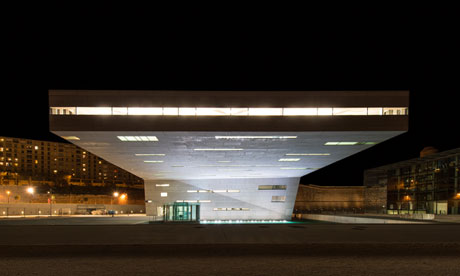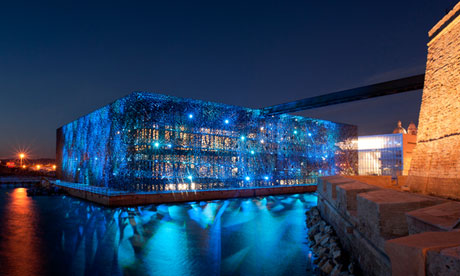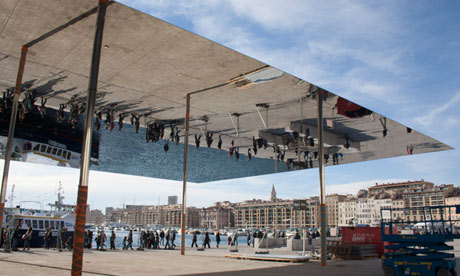The smell of cement dust and freshly caught fish wafts through the harbour of Marseille, to a backdrop of pneumatic drills and high-pressure hoses. Everywhere you look, the city is being polished and scrubbed, renovated and repainted. Roads are being resurfaced, trees are being planted, and vast new museums are rising from the ground in preparation for the European Capital of Culture 2013 – which began three months ago.
"Marseille is never in a hurry," says my taxi driver, describing how the city has been a building site for the last 10 years. As he speaks, he takes a diversion around three huge holes in the ground that will soon boast a cluster of teetering towers, part of the city's new business district. The first is complete, a brooding 140m-tall edifice by Zaha Hadid for the port's largest shipping company. It stands incongruously on the low-rise skyline, a great stack of offices squeezed into a glassy, sharply curving corset of a building.
It is a good metaphor for how this unruly city is trying to adjust to its slick new clothing. A bubbling bouillabaisse of Mediterranean cultures, France's second largest city has long suffered from its seedy reputation as a centre of drug-related violence. Twenty people were shot dead last year in the city's rundown housing estates, where youth unemployment is as high as 40%. But now the gang-plagued city nicknamed Rio-sur-Mer is being rebranded as Euroméditerranée, a dynamic hub of global investment, with a €7bn (£5.9bn) makeover – the largest regeneration project in southern Europe.
This seedy side is hard to discern from a stroll around the newly remodelled Vieux-Port, where Norman Foster's Ombrière now hangs above the repaved waterfront. A thin sheet of polished steel held 6m aloft on slender columns, Foster's sunshade (or rain shelter) turns port life upside down – from buskers to passing pedestrians, from living statues to gnarled fishermen selling their latest catch. In one single move, this giant mirror transforms the square into a magical piece of inverted theatre, a sharp rectangular slice of everyday bustle suspended in mid-air. "The space of the port is so strong," says project director Spencer de Grey. "We didn't want to make anything too visually intrusive. The structure had to have a big, transformative impact when you approached it, but disappear into the background from a distance."
 Embarrassingly shouty … the Villa Meditérranée, by Stefano Boeri. Photograph: Paul Ladouce
Embarrassingly shouty … the Villa Meditérranée, by Stefano Boeri. Photograph: Paul Ladouce
It's a philosophy of quiet intervention that does not seem to be shared by the architects operating a little way down the waterfront. Here, on the once-abandoned J4 pier, stand the flagship projects of Marseille's bid to be recognised as a cultural centre. The Villa Méditerranée, designed by Italian architect Stefano Boeri, is the first thing you see as you turn the corner of the bay, its sheer white facade butting into the dock like the rump of a cruise liner, complete with tinted oblong windows. From the other side, the building looks like a supersized diving board, with one vast exhibition hall jutting out towards the sea in a 40m-long cantilever, suspended above a pool of water in which the detritus of construction floats in forlorn clumps. So what exactly is this curious building for? It is hard to know.
"The Villa Méditerranée symbolises our desire to build a place dedicated to peace and solidarity and for reflecting upon our shared destinies," proclaims Michel Vauzelle, president of the Provence-Alpes-Côte d'Azur region, which has pumped €70m into this gargantuan project. It promises to be "a place for encounters, ideas and exchanges"; a site for citizens and experts to debate the future of the Mediterranean; an attraction where visitors will be "plunged into a subtle audiovisual experience". It was due to open mid-March; mystery still surrounds its ongoing delays and what exactly will happen within its cavernous halls.
The Villa clamours for attention on the waterfront, the embarrassingly shouty younger sibling of its more demure neighbour, the Museum of European and Mediterranean Civilisations (Mucem). An enigmatic dark box at the end of the pier, Mucem is almost eclipsed by the Villa – a strange piece of urban planning, given that this €190m national museum is of greater importance, and has been planned for over 10 years. A result of the French government's decade-long decentralisation programme – which brought an undulating outpost of the Pompidou to Metz, north-eastern France, and a series of minimalist metallic sheds to the northern city of Lens for a Louvre satellite – Mucem is the first stand-alone national museum outside Paris.
Due to open in June, Mucem is something of a coup for Marseille. Nestling beneath the craggy wall of Fort Saint-Jean, a 17th-century stronghold that once housed the Foreign Legion, the squat glass building is shielded from the harsh Mediterranean sun by a dark filigree veil. Stretched like a taut fishing net across the facade, this concrete shroud echoes the mashrabiya latticework screens used in much of the architecture of north Africa to keep buildings cool – an appropriate touch, given Mucem will explore the culture of this land just across the water.
 Brilliant, brazen move … Rudy Riciotti’s Mucem. Photograph: Lisa Ricciotti
Brilliant, brazen move … Rudy Riciotti’s Mucem. Photograph: Lisa Ricciotti
It is the work of Algerian-born French architect Rudy Ricciotti, a tempestuous and provocative iconoclast described by designer Philippe Starck as "a clairvoyant, untamable wild animal". Ricciotti's work has a raw energy to it, wrenching concrete into primal, twisted forms. Beneath Mucem's enveloping skin, a line of crooked, bony columns marches around the perimeter, supporting a ramping walkway. This fires out from the roof in a thin spear of concrete that stretches 115m across the water to pierce Fort Saint-Jean (the museum continues inside) and then leaps further across a gulley to connect the complex to the town. Exploiting the natural drama of Mucem's steep hillside setting, this is a brilliant, brazen move that, no matter what the museum houses, will provide one of Marseille's most thrilling new walks.
The idea of creating a spiralling route, off which public spaces extend, recurs in the city's major contemporary arts centre, located on the corner of a tight urban block further into town. Designed by Japanese architect Kengo Kuma, maestro of the V&A's troubled Dundee outpost project, the new home for the Regional Contemporary Art Fund is clad in a shimmering cloud of angled glass panels. "I wanted to recreate the effect of Japanese rice-paper screens," Kuma tells me, standing in one of the triple-height gallery spaces, a hard-edged mixture of exposed concrete and metal mesh screens. "The handmade glass filters the light in a more natural way."
Unfortunately, his panels do nothing of the sort, being suspended in front of a mostly opaque concrete facade. Instead, they give the building's exterior a flimsy cheapness that belies its €22m cost, and undermines the simple power of the sequence of galleries within. It reflects perhaps the most prominent symptom of the Capital of Culture: wherever it descends, it results in a spasm of accelerated projects, favouring exterior image and the power of spectacle over long-term, joined-up thinking. The Euroméditerranée development will continue until 2020 – in total bringing 24,000 new homes, 1m square metres of offices, and 150 acres of public space. This will no doubt give Marseille the economic boost it needs, although how far this will filter out into the impoverished peripheries is questionable.
The city's bold embrace of such grands projets is, however, nothing new. When Louis XIV had Fort Saint-Jean built, way back in 1660, he said: "We noticed that the inhabitants of Marseille were extremely fond of nice fortresses." Little did he know that, 350 years on, they would still be building them.


















